Giuseppe Capogrossi (Rome, 1900 - 1972) was a painter who made his mark on Italian artistic culture after World War II. Capogrossi’s production is associated with the research on the sign that, throughout Europe, was born at a time of bewilderment and reflection caused by the experience of totalitarian regimes and the catastrophe of the world conflict: as a result, the centrality of man began to be questioned. A philosophical current such as existentialism highlighted all the finite and precarious features of human life. It was a crisis that, in the visual arts scene, resulted in the introduction of new ways of working, of an alternative art. Michel Tapié first spoke of this art autre and grouped the novelties under the name informal to indicate an art that chose new methods, new gestures. This trend focused on matter, on the sign, and for this reason, in Italy, it was represented by Capogrossi’s production, among others. The latter, together with Alberto Burri, is in fact considered one of the greatest exponents of informal painting and ranks among the artists of the Roman School.
His personal contribution to the poetics of the sign, of controlled gesture, contributed to breaking with the prevailing tradition on the Italian art scene, rejecting the representation of the objective and real datum. The art that came into being, around the 1950s, allowed a new freedom of expression.
Capogrossi’s research consisted of the exploration of the power of color, based on the repetition of elementary two-dimensional elements and signs. In these he found “the primary reason” for his painting, leaving aside theory and content. This investigation led him to participate, in 1950, in the founding of the Gruppo Origine, together with Alberto Burri, Mario Bellocco and Ettore Colla. It was an experience that lasted barely a year, but it was indicative of the moment that the Italian cultural scene was experiencing after World War II.
This assumption fits perfectly with Capogrossi’s artistic research, whose art managed to be strongly emotional while relying on the reiteration of a very simple symbol and the relationship between colors. The artist thus took sides among those in Italy who professed abstraction in art, in sharp contrast to the proponents of realism. Yet Giuseppe Capogrossi did not immediately come to take this position: initially, at least until 1949, he remained a figurative painter, who “moved from the landscape and the figure,” as Maurizio Fagiolo Dell’Arco had this to say in 1999.

Giuseppe Capogrossi was born in Rome on March 7, 1900. He was descended from a noble Roman family on his father Guglielmo’s side. He was directed to the study of law, graduating in 1922. However, his strong artistic vocation soon led him to study painting: between 1923 and 1924 he began attending Felice Carena’s School of Nude, among the most prestigious in Rome in those years. In this environment he made friends with painters Fausto Pirandello, Onofrio Martinelli and, above all, Emanuele Cavalli. A painting from 1927, in which Capogrossi portrays himself alongside his friend, also remains of the latter connection. The two spent their summers together at Anticoli Corrado, a small village located in the valley to the left of the Aniene River, then in vogue among artists who wanted to surround themselves with picturesque landscapes. Here, probably, the painter began to know the need, the first symptoms of a personal inclination to search for an archaic, unspoiled environment far from the artifice of the city. With Fausto Pirandello, on the other hand, he went to Paris in 1927, which was to be followed by other numerous trips: here he had the opportunity to study the Impressionists, to get close to the art of Pablo Picasso and André Derain. But the main purpose of these trips, as the painter had to write to his brother Francesco in March 1929, was to try to fit in and make himself known in artistic circles.
Together with painters Emanuele Cavalli and Francesco Di Cocco, he made his debut in the 1927 group show in Rome, at the Hôtel Pensione Dinesen. There he presented his first works, which were still essentially figurative, including Autoritratto and Casa in demolition, both works characterized by a “minimalist realism,” according to art historian Wart Arslan’s review in his article Una mostra giovanile (published in Corriere d’Italia in June 1927). Together with Cavalli and Corrado Cagli, he exhibited at Galleria il Milione in Milan in February 1933, and at Galerie Bonjean in Paris in December of the same year. During these years Capogrossi had developed a painting style that focused on figuration and tonalism. From this period are Il vestibolo, presented in 1933 in Paris, Piena sul Tevere (1934). Things began to change in the 1940s: the postwar period was a time of intense reflection for the artist. In particular, 1946 was the year of his first solo exhibition in Rome, at the Galleria San Marco.
To the same year dates a trip to Sardinia that seemed to enlighten him. The Sardinian landscape, with its colors and lights, made him appreciate nature in its primordial context. Here developed an important knot in his artistic conception; it was a moment where he began a new contemplation of the archetypal sign and new consideration of color. He thus abandoned the pictorial language that had characterized him in the 1930s: of the figurative canvases, which also brought him a certain notoriety, not much is known. At the time of his artistic breakthrough in the 1950s, in fact, Capogrossi went in search of his still figurative paintings with the intention of destroying them. It is also likely that the works of the 1920s were still in his possession, and therefore it was even easier for him to dispose of them.
After his decisive rejection of figuration, Capogrossi moved toward a neo-Cubist reconstruction of the image. The neo-Cubist moment was brief, but it served as a transitional bridge to abstraction. The period ended in 1949: Surface 022 (1949) is one of his first abstract paintings. His first non-figurative exhibition was in 1950, at the Galleria il Secolo in Rome: here he exhibited canvases that presented his new pictorial mode, made up of reiterated signs and equal titles. In fact, the Roman painter began to call all his works Surfaces, punctually numbered.
Between 1950 and 1951, he participated in a brief experience, that of founding the group Origine together with painters Mario Ballocco, Alberto Burri and Ettore Colla. The four drafted a brief manifesto in which they stated that they “wanted to liberate artistic research from multiple superstructures,” to express “at the origin the emotion of life in the mystery of its unfolding.” The group organized the “Origine Group Exhibition” at the Origine Gallery in Rome, but soon disbanded, lasting barely a year. After this brief interlude, Capogrossi continued to be successful and exhibited at major art shows in both Europe and America. By the height of 1951 he had achieved notoriety: he collaborated punctually with the galleries Il Cavallino in Venice and Il Naviglio in Milan. From here his works began to spread, and were also sold abroad. Still in 1951 he exhibited regularly in several group shows in Paris, later coming to London and Stockholm. In the following years he worked extensively in America: two solo exhibitions at the Leo Castelli Gallery in New York and Galleria Sistina in São Paulo (both 1958) are worth mentioning.
Giuseppe Capogrossi also had contact with the decorative arts, devoting himself to the production of glazed ceramics and even lending his designs for tapestries. These productions were still new ideas for continuing to propose his rhythmic, toothy sign, demonstrating the painter’s inexhaustible will to explore and research. The artist became so recognized and established that in 1968 Palma Bucarelli, director of the National Gallery of Modern Art in Rome, dedicated an entire room to his works. And also in the Italian capital Capogrossi died, on October 9, 1972. In this same year, the painter’s heirs (daughter Olga, grandson Guglielmo) began to collect the documentary material of his activity. TheCapogrossi Archive was established in Rome, with the aim of protecting and promoting the study of the artist and his production.
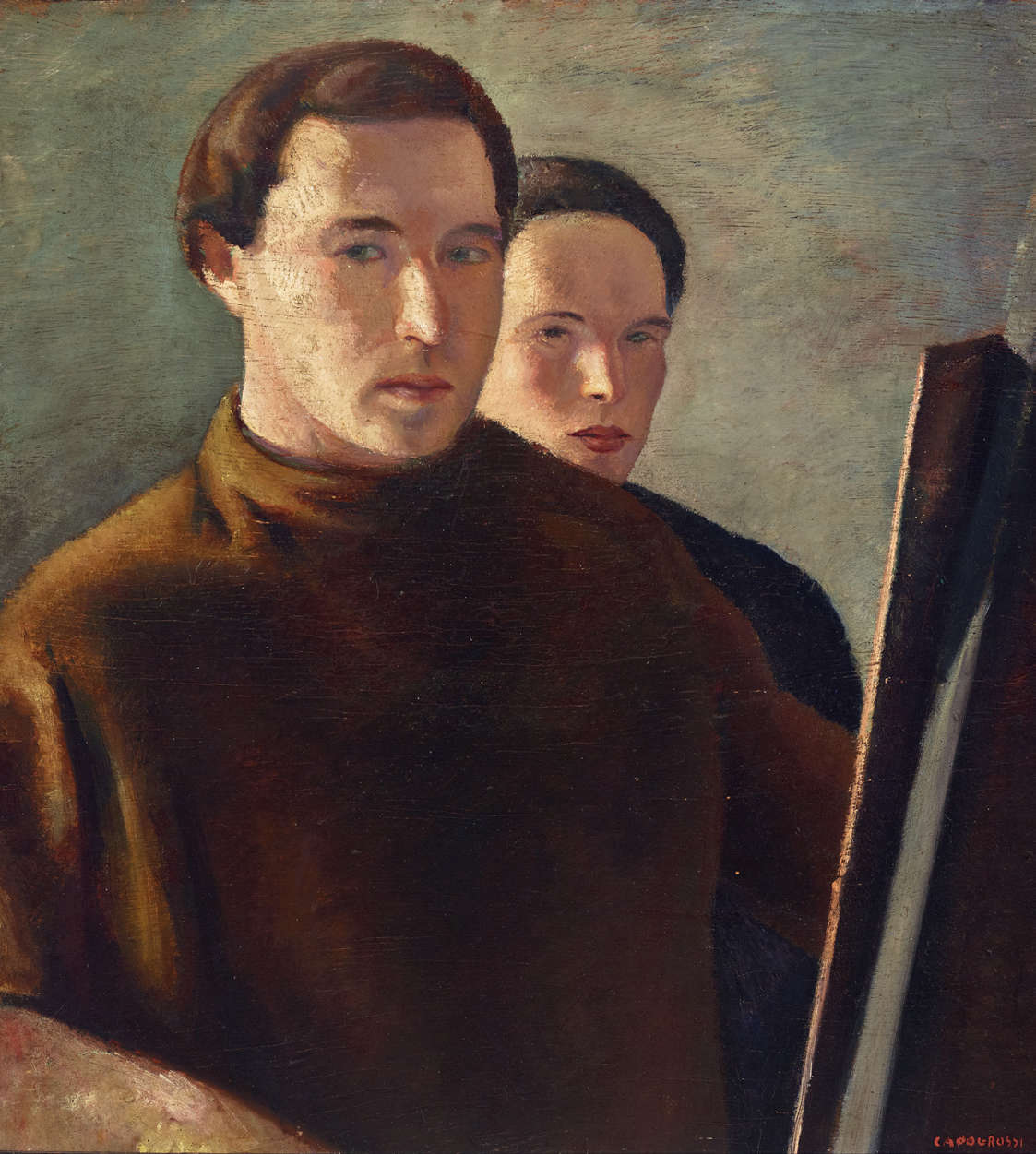
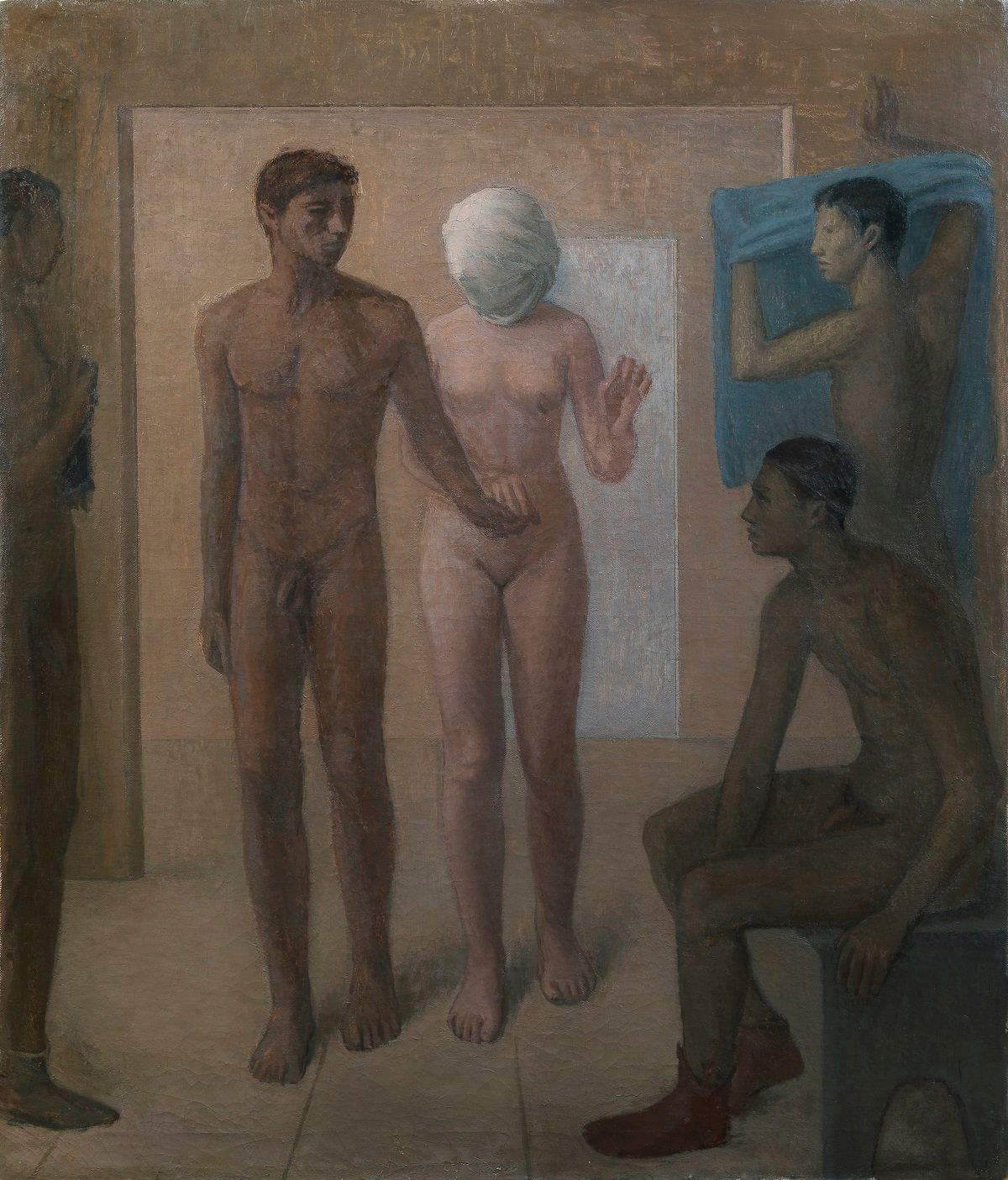
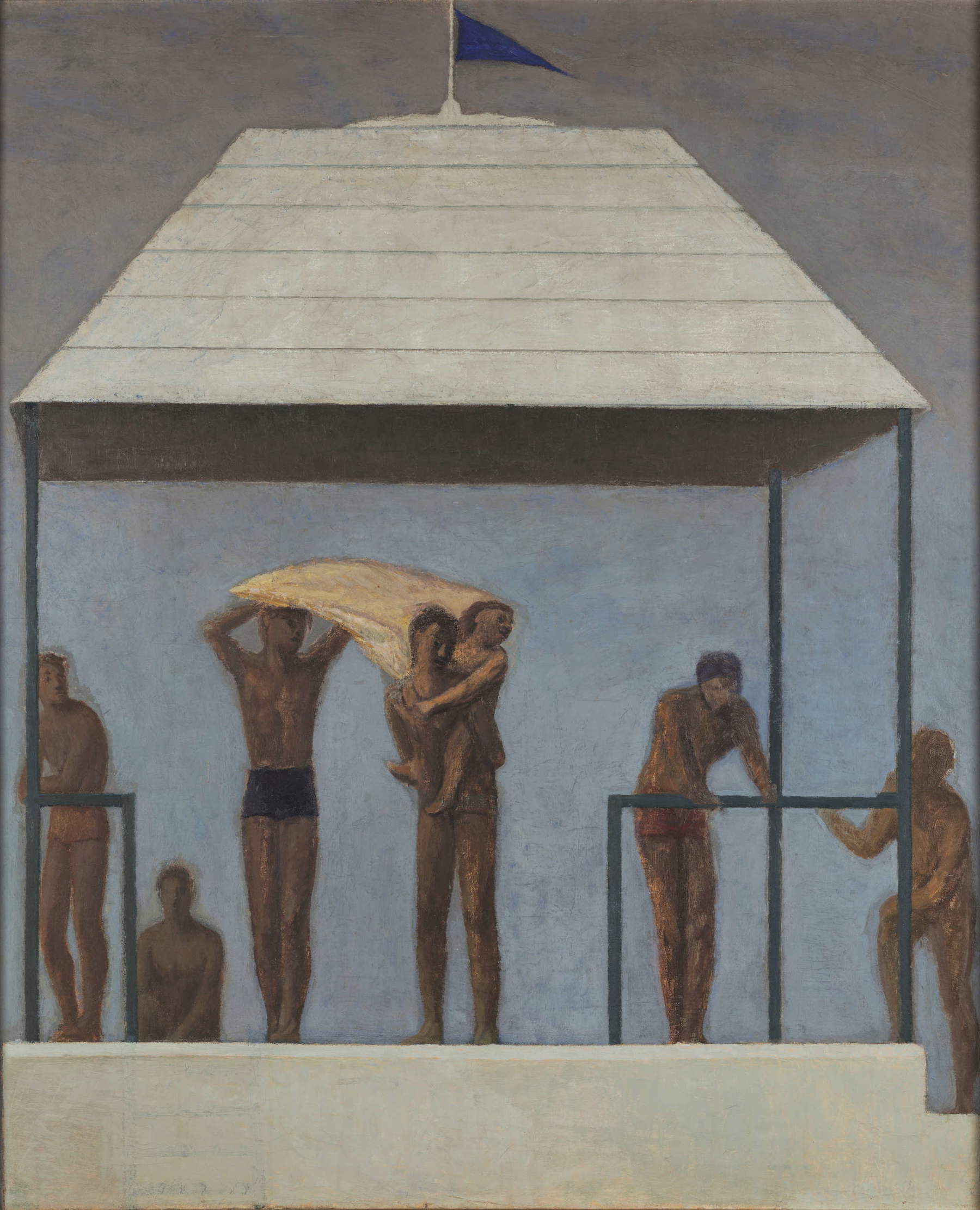

Because of the way he treated matter, the consideration he had for color, sign and gesture, Giuseppe Capogrossi is considered one of the main exponents ofItalian Informal art.
His early artistic activity was figurative and tonal. Capogrossi moved from landscape: in 1927 he made House in Demolition, a work that reveals a quick pictorial study, mindful of the Impressionist experience he had the opportunity to study on his frequent trips to Paris. Here he tried to sink the atmospheres into a kind of grayish-brownish mist, of dull, agreeable hues, enlivened here and there by timid illuminations.
The early Capogrossi uses quick but sure brushstrokes, aimed at shaping forms. In this panel one senses a confidence that the painter placed in the power of color, to which he let the entire representation be composed. He exclusively allowed the pictorial material to suggest objects, as in the case of the vehicle on the right, or in the stairs descending to the river. House in Demolition is an oil on panel, as is Self-Portrait with Emanuele Cavalli, made in the same year. The artist painted himself together with his friend, both looking at the viewer with a fixed, silent but eloquent gaze: this work is also characterized by a warm tone, the palette playing on earths and ochres.
The mid-1930s is characterized by a realism in the definition of the scene and an element of mystery. A stillness of figures that recalls Piero della Francesca. Vestibule, oil on canvas from 1932, presents an enclosed room in which several nude individuals stand. The male figure revealsCapogrossi’s interest in Picasso’s painting (see, for example, Two Young Men, by Pablo Picasso, whose gait the male figure recalls). Again, central at this time is Capogrossi’s use of color, to which he entrusts the creation of forms and the management of spatial depth. In The Storm, of 1933, figuration is built on archaic memory. The characters are crystallized in their gesture, they do not communicate but remain poised between the physical and the metaphysical. Full on the Tiber, from 1934, is a painting in which the cabins create a visual barrier and presents a moment of suspension, animated only by the figures on the left.
During the 1940s Capogrossi’s interest in figuration dissolved. His artistic vision began to multifaceted, and his continued contacts with the Parisian milieu led him to visit the neo-Cubist lesson. In 1948 he made The Two Guitars: in this work there is more drawing, the lines are quite sharp and decisive. Color is still the protagonist but leaves more room for a clear division of forms that become squared off. Here the painter began a quest made of geometric elements that later led him to an ever greater simplification of the scene. The outcome of this exploration was a result like that of Surface 022 (1949): pure forms and pure abstract signs were stacked on the white background in the absolute black-white pair. Capogrossi focused on a single form, an archetype that he reiterated in an orderly manner; the rhythm here is marked by that one key-sign in black, which is repeated in orderly rows varying its structure little by little, without ever abandoning its sign principle. With this 1949 painting, Capogrossi lost all contact with realism and entered the wake ofabstractionism.
In Argan (1967) we read, “These early paintings are not so much works as ’research of the sign.’” Superficie 022 was first exhibited in 1950 at the very Galleria Nazionale d’Arte Moderna in Rome, where it is still kept today. This was Giuseppe Capogrossi’s first solo exhibition of abstract works. From here on, the production was essentially based on the rhythmic repetition of elementary signs. Comb shapes, trident shapes and fork shapes: all two-dimensional archetypes reproposed in numerous variations, each time reorganized into new combinatorial and chromatic solutions. The direction of the sign rhythm could be horizontal, vertical or diagonal, but, from now on, Capogrossi always entitled them Surface, flanked by a progressive number. The surface of the canvas became, in the painter’s mind, a kind of degree zero, an ideal field where elements could be ordered and intersected to create an original rhythmic relationship each time.
From 1950 is Superficie 596: the sign is almost primordial, repeated and stacked to form parallel rows in a very free management of space. Superficie 608, made the following year, is a work already different from its predecessor of a year earlier. The signs, executed in black tempera, may also diversify, are modulated, but the archetypal origin is always basic. Painting is placed as an agent, something that activates spatial dynamism. Space, in turn, is generated moment by moment by the eyes of the viewer who participates in the movement by reading and traversing the rhythmic scansion proposed by the solids and voids, both of which are necessary. The intervals, in this paper spread on canvas, are important because they contribute to the rhythm with the same importance as a pause in a piece of music. In 1956 Capogrossi made Superficie 154: on a light background, black marks are arranged small in rows. These are then repeated, in larger sizes, in the foreground. The classic bichromatic choice of black and white is energized de red and orange inserts. The composition returns an archaic flavor, timeless for the originality of the proposal, which always orbits around that primordial element, placing it as a part in a fundamental, archetypal and imaginary alphabet.
From the experience Capogrossi pursued in the applied arts scene, there remains a tapestry, Astratto, now owned by the National Gallery of Modern Art. Designed in 1963 for the Turbonave Michelangelo, Capogrossi also lent his sign vision to the more important art of weaving.

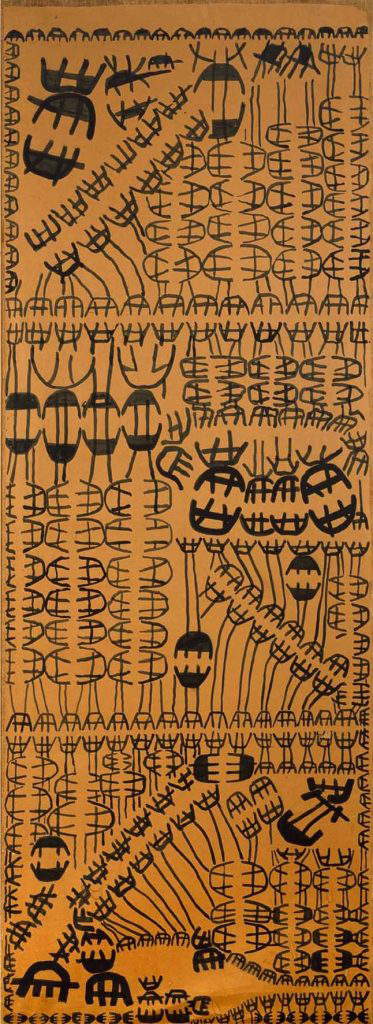

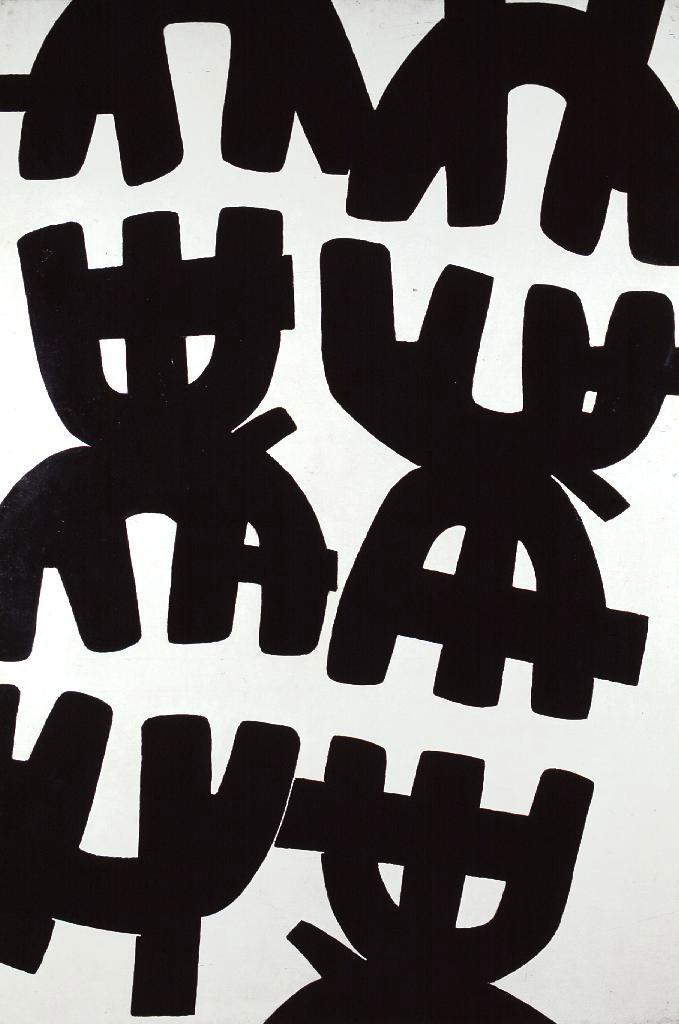
In Italy, many of Giuseppe Capogrossi’s works are now in private collections. At the National Gallery of Modern Art in Rome are several works by the painter, including Surface 018 (1948), Surface 022 (1949) and also Surface 335 (1959). Also preserved here is the tapestry Astratto (1963) but also one of his still figurative paintings, Il temporale (1933). In Turin, at the Galleria Civica di Arte Moderna e Contemporanea, are Superfici 89, 102,141 and 213, all made in the early 1950s.
Surface 154 (1956), mentioned above, is in Milan, owned by the Banca Intesa Collection. In Venice, at the Peggy Guggenheim is Superficie 236, oil on canvas from 1957. At the Mart in Rovereto is Superficie 678 (Carthage), an oil on paper applied to canvas from 1953.
Abroad, two works from 1953, presented under the titles Composition and Section 4, are at the Museum of Modern Art in New York. Also in New York, the works Superficie 210 (1957) and Superficie 236 (1957) are kept at the Solomon Guggenheim Museum.
 |
| Giuseppe Capogrossi, life, works and style of the sign artist |
Warning: the translation into English of the original Italian article was created using automatic tools. We undertake to review all articles, but we do not guarantee the total absence of inaccuracies in the translation due to the program. You can find the original by clicking on the ITA button. If you find any mistake,please contact us.